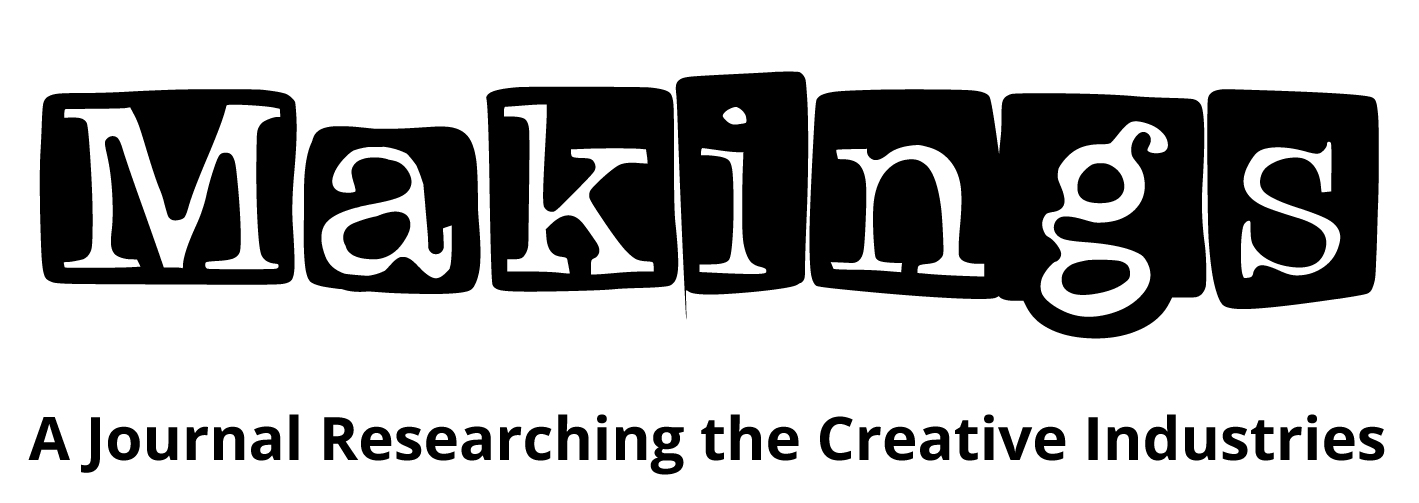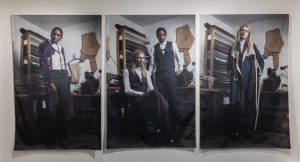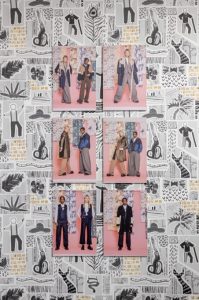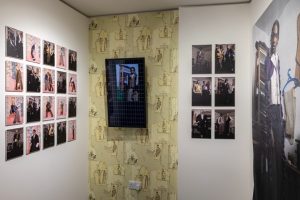
The Legacy of the “George Saunders Reimagined” Exhibition
By Louise Martin, Lecturer in Foundation Fashion & Textiles, Birmingham City University
In June 2023, the National Trust and Birmingham City University (BCU) School of Fashion and Textile students and academics came together at the Birmingham Back to Backs Museum to celebrate the launch of the George Saunders Reimagined exhibition, which honoured George Saunders’ remarkable life and highlighted his story of migration to Birmingham.
This case study will discuss how this collaborative project has united people from diverse cultures through the realisation of meaningful craft-based outcomes inspired by the life and work of George Saunders. It explores key themes emerging from the collaboration between Birmingham’s National Trust Back to Backs team and BCU’s students and academics: heritage, migration, craft, and diversity.
The Brief
The National Trust’s Birmingham Back to Back’s team initiated the project to highlight George Saunders’ story, his life, and work as a master tailor. The Back to Back’s team wanted to work with young people to improve their awareness of migration and appreciation of working people in Birmingham in the late 20th Century. Birmingham’s demographic landscape and cultural fabric has been shaped by the city’s international attraction for migrants. This has led to a rich heritage which has made Birmingham a creative hub with a vibrant arts scene, celebrating diverse cultural legacies.
George was a skilled tailor from Saint Kitts who came to Birmingham in 1958 to help fulfil the labour shortage, as part of the Windrush Generation. George established a reputable tailor’s workshop, making uniforms for the Queen’s Guards, celebrities, and West Midlands community. He helped to challenge how migrants were perceived in Birmingham by establishing a business valued by many, helping to raise the profile and acceptance of a Black man in a non-inclusive society. The Trust credits George as helping to save the Back to Backs buildings from redevelopment during the 1980’s by establishing a thriving business. When George retired in 2002, he donated his equipment and materials to the Back to Backs, which turned his workshop into a collection and created an archive of over 800 possessions, celebrating the UK’s only collection of work by a Caribbean tailor. The National Trust has commemorated George’s life, sharing his story and significant impact on the local community, whose legacy still lives on today (National Trust, 2023).
In April 2022, Isobel Grove, Senior Programming and Partnerships Officer from the National Trust Back to Backs team sought a local education institute that specialises in the study of fashion and textiles to collaborate on this project. The aim of the project was for the students, guided by BCU’s academics and National Trust curation team, to explore the George Saunders collection and create a diverse range of outcomes based on his artefacts, taking inspiration from his migration to the UK and his tailor’s workshop.
Initially, the project appealed to me as I felt it was a great way to inspire and engage the diverse cohort of Foundation Fashion & Textiles students. After a site visit, I felt that the scope of the project and responsibility to justly celebrate George Saunders could only be realised across the whole School of Fashion & Textiles, to maximise this great collaborative opportunity for the students.
The Project
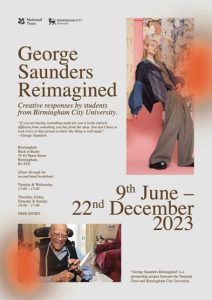
The George Saunders Reimagined exhibition ran for seven months from June to December 2023. The exhibition celebrated BCU’s School of Fashion and Textiles’ students own creative responses and outcomes inspired by George’s experiences. The students created new garments using George’s original paper patterns, wallpaper designs, textile samples, fashion designs, clothing, digital media and photography all instigated by George’s heritage, life and work.
From September 2022, the Back to Backs team generously shared access to the existing George Saunders collection, which enabled the students from Foundation entry to graduate level to interact with, engage in, and explore these fascinating artefacts. Motivated by George’s designs and tailor’s shop, the students embarked on a creative journey to produce exciting outcomes such as:
- Garment Technology students produced garments based on his original patterns.
- Fashion design students designed and constructed outerwear jackets based on their own personal heritage.
- Fashion Branding and Communication students designed shop windows to showcase George’s work and life.
- Foundation and Textile students developed wallpaper and fabric designs inspired by his workshop environment.
- A final year costume design student focused on a tailoring brief.
At all levels the students produced sketchbooks and portfolios, which explored the theme of heritage. A total of 44 students had their work displayed at this national exhibition, which provided the students an opportunity to meet and work for an external business partner. The exhibition was promoted on the National Trust’s global website and in their members magazine, with a readership of approximately four million. Plus, marketing through BCU’s website, Inspired festival, and external advertising highlighted the exhibition nationally.
Throughout the project the students were supported by lecturers from the School of Fashion and Textiles, who created and delivered briefs, a series of lectures and workshops to support their personal development. The briefs’ aims and expected outcomes are as follows:
Aim: Aligned with the National Trust’s ‘Celebration of Fashion in 2023’, the organisation is looking to explore the potential of the George Saunders collection through contemporary creative practice, engaging current and new audiences with themes that remain highly relevant today – migration, heritage, community, and enterprise.
Outcomes: Develop a garment / a collection of wallpaper and fabric designs inspired by the tailor George Saunders, whose archive is held at the Back to Backs in Birmingham, where he used to work. The designs should amplify George Saunders’ heritage, work and story in a way that is relevant to younger generations today. Your outcomes need to be celebratory, attract attention and be original.
The exhibition was curated into different sections: Introduction, Heritage, Design and Process, Tailoring, Wallpaper Design and Realisation to help the audience navigate the space and interact with the exhibits. Student outcomes were selected for each location based on merit and effective communication of the brief.
Each section was identified with a descriptor explaining the focus of the body of work produced by the students. The introduction section outlined the context of the exhibition, the partnership, and how the students were inspired by George Saunders’ collection and story to create their own responses.
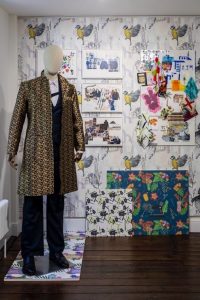
The Heritage section celebrated the diversity of the students’ backgrounds as they drew inspiration from their personal heritage and cultural backgrounds to produce innovative craft-based results. Work included outcomes developed from Portuguese, Brazilian, Philippine, African, Chinese, Indian, Irish, and English cultures, including local West Midlands references. Outcomes were rich in cultural traditional design expressed through colour, texture, processes, shape and form and enabled each student to celebrate their personal family history providing a sense of pride.
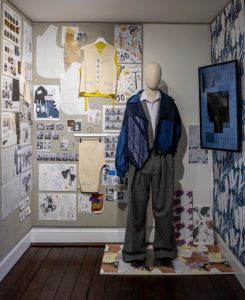
In the Design & Process section the work illustrated the students’ understanding of design, creative pattern cutting, construction, and finish. Level 5 Fashion Design students specialising in Garment Technology utilised George Saunders’ original patterns known as blocks to construct a range of waistcoats and trousers. Inspired by George’s 1970’s pattern blocks, the students were tasked to produce outcomes that were both historical and future facing. This further extended their research into designs from the 1920s to 2020’s exploring style, cut, creative elements, fabrics, trims and finish. The development of technical craft skills was essential for these students to realise their projects, with focus on technical details such as structured pockets, fly, waistband development and the finish of sleeveless garments. The sample pieces attached to the notice boards provided an insight into the students’ research and design process, as they evolved their original designs, patterns, and toiles.
The garments showcased in the tailoring area were created by Level 6 (Third/Final year undergraduate) student Claire Bradbury, a costume design student. Inspired by the suits of George Saunders from the 1970’s and her own work experience at a tailor’s workshop, Claire designed and created two tailored three-piece suits. Claire developed the craft of tailoring through her garment production realising one full garment using bespoke tailoring techniques, in which a bespoke pattern was made for each piece of apparel.
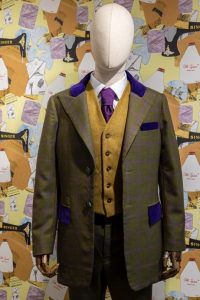
The exhibition included pattern pieces, toiles and samples produced by multiple students in the process of developing their final customised garments. Claire also produced two half-scale suits to illustrate the internal workings conveying the labour-intensive craft process utilised to construct the garments. The positive impact this experience has had on Claire is clearly illustrated in her quotation, referenced in the exhibition:
“I am very excited and thankful for getting this opportunity to work alongside the National Trust on this special exhibition while studying here at BCU. To be able to reimagine some of George Saunders work and showcase this at the Back to Backs here in Birmingham is very exciting and I am proud to say members of the public will be seeing and hopefully enjoying my work.”
Throughout the exhibition were a range of wallpaper designs by Level 4 (Foundation and First year undergraduate) Textile Design students. These inventive wallpapers are used as a backdrop for each section unifying all the design elements to convey George’s experiences of migration, heritage, community, and enterprise. The wallpaper designs are generated through the creation of a range of motifs, dynamic shapes that are the ingredients of a design. The motifs have been structured in a harmonious composition building rhythms that were repeat pattern statements, celebrated across the exhibition.
The Realisation area is the culmination of the exhibition, where all the student outcomes are showcased, highlighted by dramatic large-scale photographs that dominate the space. It features a photoshoot of fashion styled, look book images, with commercial models presenting a professional final outcome. The large-scale photographs present the models wearing the Level 5 (Second year undergraduate) Garment Technology students’ waistcoats and trousers inspired by George’s original pattern blocks, styled with a classic white shirt and the outer jackets designed by the Level 5 Fashion Design students. The photoshoot is set in the museum, amongst George’s tailoring workshop and equipment, sewing machines, materials and patterns, providing a powerful reference to his work and life. Other smaller photographs feature the models wearing the garments set in a studio with a backdrop of the Level 4 textile students’ wallpapers, helping to showcase the garments and connect all elements of the exhibition.
The heightened visual communication of this section enables the audience to reconnect with all the key elements and themes presented in the exhibition. This reinforces the significance and impact George has had on the students, leading to their accomplished outcomes, self-discovery, celebration of their heritage and further development and refinement of their craft skills.
Many challenges arose during the planning, project management, design, curation, and installation of the exhibition. As a new collaboration between the National Trust and BCU, various aspects had to be explored and negotiated to satisfy both partners. With the Trust funding and housing the exhibition, careful discussions ensured BCU met their brief and expectations. A Memorandum of Understanding (MOU) outlined their relationship. Isobel effectively project-managed the exhibition onsite at the Back to Backs, skilfully handling the budget to prevent overspending. However, the restricted budget impacted certain aspects of the curation. For example, the purchase of computer monitors was reduced from five to two, prompting a rethink of how digital and video elements were incorporated into the exhibition space.
At times, communication between the Back to Backs and the BCU team was inconsistent. Some academic staff, responsible for different project elements, did not provide regular updates. Although this was eventually resolved, it caused issues during the installation phases. More consistent communication, including regular updates from all parties, is needed in the future.
Challenges arose in designing and curating the exhibition, as key elements were still in production weeks before installation. Planning a space and selecting items for unfinished work was difficult. To address this, Louise built relationships with students to support their time management and understand their designs. She also enlisted BCU technicians to ensure all elements were completed on time and to a high standard. Exhibition descriptors, designed by an external graphic designer, were completed in advance, but student name plaques had to be added and printed last minute. Fortunately, the graphic designer was supportive of these tight deadlines. Additional assistance from key lecturers in updating the descriptors and the patience of the printing company ensured all graphics were completed on time.
As the National Trust exhibition space is on the first floor of an 1830s building, several structural factors impacted the installation. Access was restricted to a narrow, height-limited staircase, which constrained the size of materials and equipment. Large Sundeala notice boards (2440mm x 1220mm) were purchased and intended to be mounted as full panels for a seamless, joint-free look. However, during the build, they had to be cut down in the museum’s courtyard, timed around opening hours, to fit up the staircase. These factors, along with other exhibition elements, affected the installation timeline for the employed exhibition technician and the BCU team. Hanging the commercially manufactured student designed wallpaper was time-consuming, delaying other aspects of the setup. Additionally, mounting individual samples and designs onto the Sundeala notice boards proved difficult, requiring nails and a hammer, and took far longer than expected.
Reflecting on these challenges is essential to improve time management and ensure future projects are managed more efficiently, applying lessons learned.
The Exhibition’s Success
The success of the exhibition is evident on a personal, educational, and commercial level for students, academics, and the Back to Backs team. This success can be clearly evidenced through feedback gathered from anonymous visitors to the exhibition:
- “Extremely well laid out… exhibition was informative and brought back memories from the era.” Anonymous 2023
- “Excellent use of exhibition space. Loved the story telling and open interpretation. Very relevant and local.” Anonymous 2023
- “Students work was excellent, collages and drawings. Nice collaboration with the university. Poignant connection with history and George.” Anonymous 2023
- “Loved the fashion exhibitions, shows how history is still relevant today.” Anonymous 2023
This success has extended to the students, as commercially their work has been projected on a national stage. The promotion of the exhibition, social media, National Trust’s marketing, national and local press coverage, has supported the students’ career prospects and future endeavours.
The collaboration has served BCU well, building relationships with a new industry partner, raising the national profile of BCU’s School of Fashion and Textiles locally, as the Back to Backs Museum has approximately 30 thousand visitors a year. For Birmingham’s Back to Backs team the exhibition has helped to build a strong working relationship with a reputable local University, extending its customer profile reaching out to a younger audience and an increased footfall to the museum of 6,516 visitors who attended the exhibition. Below is a quotation from Isobel Grove who articulates the value of the exhibition’s outcomes to the National Trust nationally and extended community.
“We were delighted to partner with Birmingham City University for George Saunders Reimagined as it helped us to develop a deeper understanding of the George Saunders collection and the practice and skill of George as a tailor. Not only this, but it enabled us to share his story and the Back to Backs with a younger audience and broadened our existing visitor base. The exhibition (unlike the museum collection) was outside of the pay barrier meaning that George’s story was shared more widely and beyond the existing National Trust audience. The project also provided the Back to Backs with an important legacy, in the form of a handling collection for the George Saunders collection that can be used for events and education programmes.”
For the student exhibitors, interviewed by Birmingham Live’s reporter Husna Anjum (Anjum, 2023), it is evident the impact and personal growth they have experienced. Natalie Matthews draws on the technical knowledge of the tailoring craft that she has learnt and developed through her transformed outcomes:
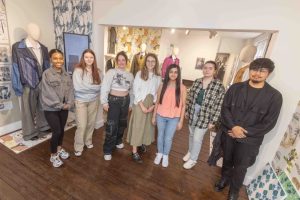
“It was really fun to learn about George and his heritage and also learn about his craft and use that to inspire our own work. I have done the waistcoat and trousers inspired by George’s tailors and trying to modernise them with 21st century techniques.”
Both Katie Garcha and Sean Pajarillo drew on their own personal heritage, learning from their parents’ experiences and culture. Katie’s jacket design was based on her Indian heritage, reflected through the shape, detailing and fabric choice. Sean’s portfolio page illustrated his parents’ experience studying as nurses in the Philippines and their migration to the UK to work. Sean has drawn key connections between his parent’s and George’s migration. He explained the similarities he drew from their shared dedication to their vocations, regardless of racial conflict. During the COVID-19 pandemic his parents endured racial abuse, but they continued to work hard and save lives.
“I took George Saunders’ experience as a migrant coming to the UK and the same experience of Filipino nurses who migrate and bring American medical history to the UK, working as frontline workers during Covid.”
Inspired by his own experiences, Sean translated his research on nursing imagery in the Philippines into fabric samples created from old medical scrubs. This exploration culminated in a final garment made from scrub materials, symbolising his parents’ experiences as frontline workers during the pandemic.
A fellow student’s work, whose fabric sampling was exhibited, reflects themes of migration and diversity by drawing inspiration from their grandmother’s experiences during World War II, using family photographs, diary entries, and historical research to capture her journey. Through pattern cutting, hand-stitching, and fabric sampling, she explored her personal and cultural heritage, translating these stories into a meaningful garment, a personal tribute to her grandmother. The project highlighted the resilience of past generations while celebrating diversity through a deeply personal lens.
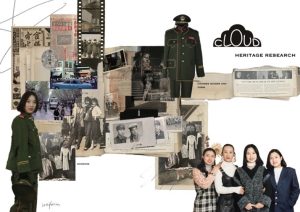
This student’s portfolio page reflects themes of migration and diversity by drawing inspiration from their mother’s service as a veteran in 1980s China, using her faded military photograph to explore the evolution of military uniform design. By merging functional elements such as gun bags and pockets with popular suit styles of that era, the project highlights a blend of cultural heritage and modern fashion trends, contributing significantly to the student’s design realisation and deepening their understanding of personal heritage.
Mahalia Ellis shared Caribbean heritage with George motivated her shop window display to promote the exhibition and permanent George Saunders Exhibition at the Back to Backs.
“I designed boards and collages inspired by Saint Kitts and Birmingham…It is definitely something I can relate to and seeing these images brings me back to being at my nans and seeing posters and Caribbean bits and pieces.”
The educational transfer of knowledge and skills is evident throughout all the students’ development. Their understanding of the value of their personal connections to their cultural heritage informed their evolved outcomes. Equally the knowledge learnt from George’s craft skills as a stimulus in the creation of their informed practice, has been hugely impactful on the students. The students recognised the significance of the racial exclusion that George and their families experienced, which made them more determined to succeed.
This live project has helped to shape future pedagogical approaches from the knowledge gained and shared from these experiences. The academics’ teaching practice has been influenced by the cultural learnings, heritage, and personal struggles that George and the student’s families have encountered. These learnings have impacted the methodology of future pedagogical practice to ensure that they enable personal growth and inclusive reflection. Decolonising the curriculum and embedded global references are key elements of the teaching responsibility that academics need to embrace, to enrich references and stimulate diversity of thought and action.
Below is a quote from Zoe Hillyard, Textile Design Course Leader, who managed the project brief for her level 4 students responsible for the exhibited wallpaper designs. Zoe highlights the lasting impact of this project on the student’s development.
“Engagement with an off-site archive provided an inspiring and enriching context for learning, especially for a first-year cohort, many new to the city and, like George, adjusting to a new cultural environment. Most had never visited the Back-to-Backs before and were amazed by the rich resource on their doorstep. It supported conversations about personal experiences which helped build cohesion within the group and confidence in creative self-expression through visual language related to textile design. The impactful wallpaper concepts were a fusion of their own and Georges experiences. The exhibition fostered a strong interest in design for interior spaces and cultural expression, clearly evident in the graduate collections the cohort are about to showcase to conclude their undergraduate studies.”
The Project’s Legacy and Next Steps
The legacy of the George Saunders Reimagined exhibition has been illustrated throughout this case study, but the ongoing legacy and the next steps need to be determined. The Birmingham based craft charity Craftspace spearheads creative programmes to create contemporary crafts for broad, cultural outputs. Craftspace employs the power of creative practices to bridge communities and build enterprise. The resurgence of craft with a more community centred attitude has been charted by the global trend forecasters WGSN since the early 2020s, in trend reports such as Resourceful (WGSN, 2022) and Common Connections (2023). The reports demonstrate how craft can help us to embrace and connect with our own personal heritage to support collaborations with diverse cultures within our communities.
This sentiment is echoed by the Crafts Council who believe that craft can help develop compassion and understanding of different cultures, engaging craft practices to help challenge inclusivity issues, as referenced by their Equity Advisory Council in 2022.
“We believe that craft skills and knowledge enrich and uplift us as individuals, and, in doing so, will change our world for the better. Diversity of all kinds enriches creative practice, and we recognise the moral, economic, and social reasons to make diversity, inclusion and equality central to our work.”
(Crafts Council, 2023)
Learning from other approaches will help to develop the legacy of this collaboration further. The collaboration is a sound example of how a stimulus such as craft can be utilised to celebrate and embrace diverse cultures enriching education, society and communities.
Following this, the next steps included:
- Craftspace’s exhibition Dorcas Stories from the Front Room shown at the Mailbox in September 2023 featured student work produced for the Reimaged exhibition to highlight Caribbean textile narratives that celebrates 75 years of Windrush through the production of textile crafts, fashion, and Dorcas Clubs.
- A satellite George Saunders Reimaged exhibition at BCU’s Parkside building, ran April to June 2024.
- In 2025 Leamington Spa’s Art Gallery will feature garments produced for the exhibition.
- As part of the original exhibition the National Trust identified a winning Wallpaper design by Rebecca Tombs, for permanent use within a top-floor room within the Back to Backs Museum, showcasing both the individual student and BCU.
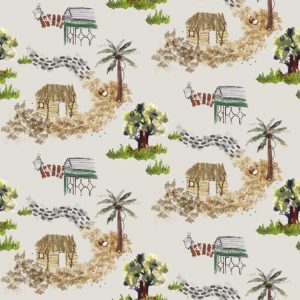
A further lasting impact of this partnership is a planned project aligned with BCU’s 2030 vision, aimed at developing community engagement and driving economic growth. In 2026, a new exhibition will showcase students’ cultural perspectives and celebrate local communities, displayed at the Back to Backs for a year across two floors. The project will also provide valuable real-world experience through industry placements and workshops facilitated by the National Trust.
The student’s original designs have successfully amplified and celebrated George Saunders’ story in a way that is relevant to younger generations today and Birmingham’s diverse community. The positivity that the exhibition has generated is clearly evaluated by Hannah Gidley, General Manager for the National Trust’s Birmingham properties:
“The students we’ve collaborated with from BCU are so talented, and it’s a pleasure and a privilege to see and share their process, their skill, and the art that his story has inspired. It’s one thing learning about a person and his life and work, but quite another to see people respond by designing, crafting, making and modelling. It’s been a joy to explore and experiment with such a great partner.”
Through successful collaborations we can all can learn from entrepreneurs such as George Saunders. Determined to fit into a prejudiced world George utilised his craft skills to build a business that contributed to the economy of Birmingham. As his exhibitions continue to attract audiences and celebrated by the National Trust, George’s legacy will continue to thrive and provide cultural significance nationally, and to Birmingham’s local communities. Heritage, craft, and a better recognition and understanding of equality and inclusion are all clear threads that are the legacy of this exhibition.
References
Anjum, H. (2023) “Students honour late Windrush tailor George Saunders with fashion exhibition”, Birmingham Live. Available at: https://www.birminghammail.co.uk/whats-on/arts-culture-news/students-honour-late-windrush-tailor-27081308 Accessed 26.3.24
Crafts Council. (2023) “Diversity and Inclusion. Our Commitment” Available at: https://www.craftscouncil.org.uk/diversity-inclusion/commitments Accessed 27.3.24
National Trust. 2023. “Black history in Birmingham: the story of George Saunders” Available at: https://www.nationaltrust.org.uk/visit/birmingham-west-midlands/birmingham-back-to-backs/the-story-of-george-saunders Accessed 26.3.24
WGSN (2022) “Resourceful” Available at: https://www.wgsn.com/interiors/article/88740#page_2 Accessed 28.3.24
WGSN (2023) “Common Connections” Womenswear Forecast S/S 25. Available at: https://www.wgsn.com/fashion/article/64aece77bc74e2b665924604#page1 Accessed 28.3.24
